Joyce Trying To Mother Billy When She Realizes His Situation At Home (as A Mother Who Raised Two Boys
Joyce trying to mother Billy when she realizes his situation at home (as a mother who raised two boys in that environment) and Billy assuming she wants him like all the other moms in town. So he plays up the charm, is sweet on her, and Joyce thinks he’s finally warming up to her, finding a home at her house. Then he goes to make an actual move on and she is just like “wOAH MISTER”. She’s ready to scold him to high heavens until he snaps that he just assumed she was like the rest of them, pride hurt, and Joyce rants on for like an hour about the audacity of these women, that he has nothing to feel ashamed, honey, for pursuing them because they shouldn’t have reciprocated and blows a fuse when she asks for a list of names and he mentions Karen. She makes the woman apologize personally to Billy at 10pm at night, and he is just mortified and wants to be anywhere else because please Ms Byers I’m an adult you’re ruining my street cred right now
More Posts from Dipstickflopdoodle and Others
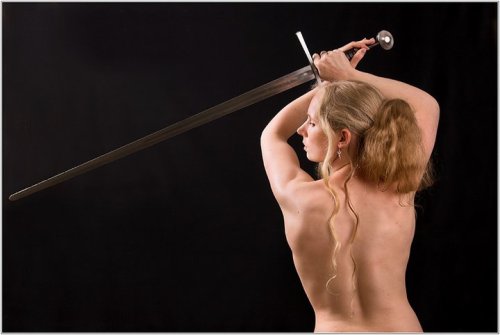
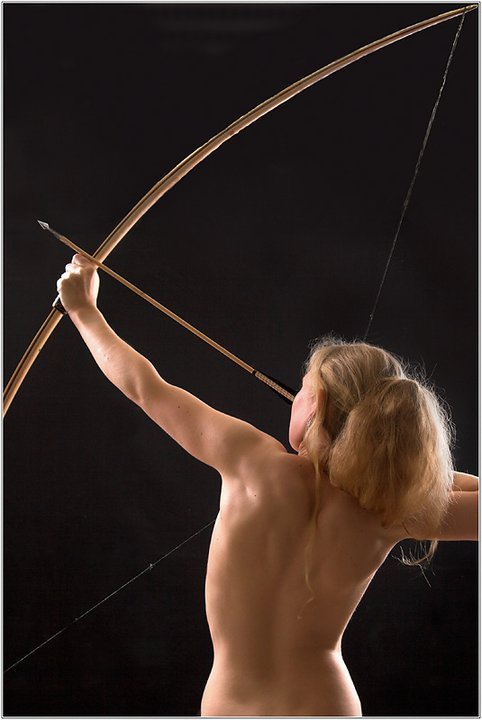
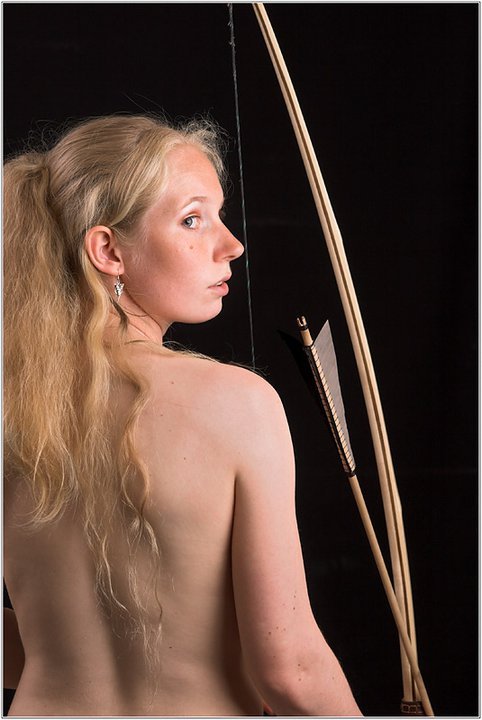

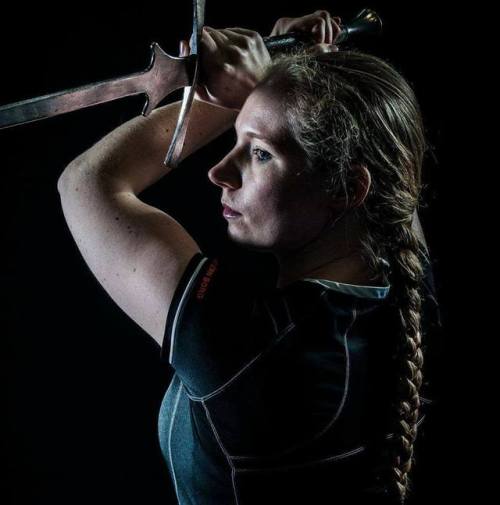

Dutch longsword fencer Tosca Beuming
Photographed by Martin Philippo and Andress Kools
Divine Love Jar
This spell can be used either to attract love to you, or help you better love yourself. Set your intent and focus on it while filling your jar.
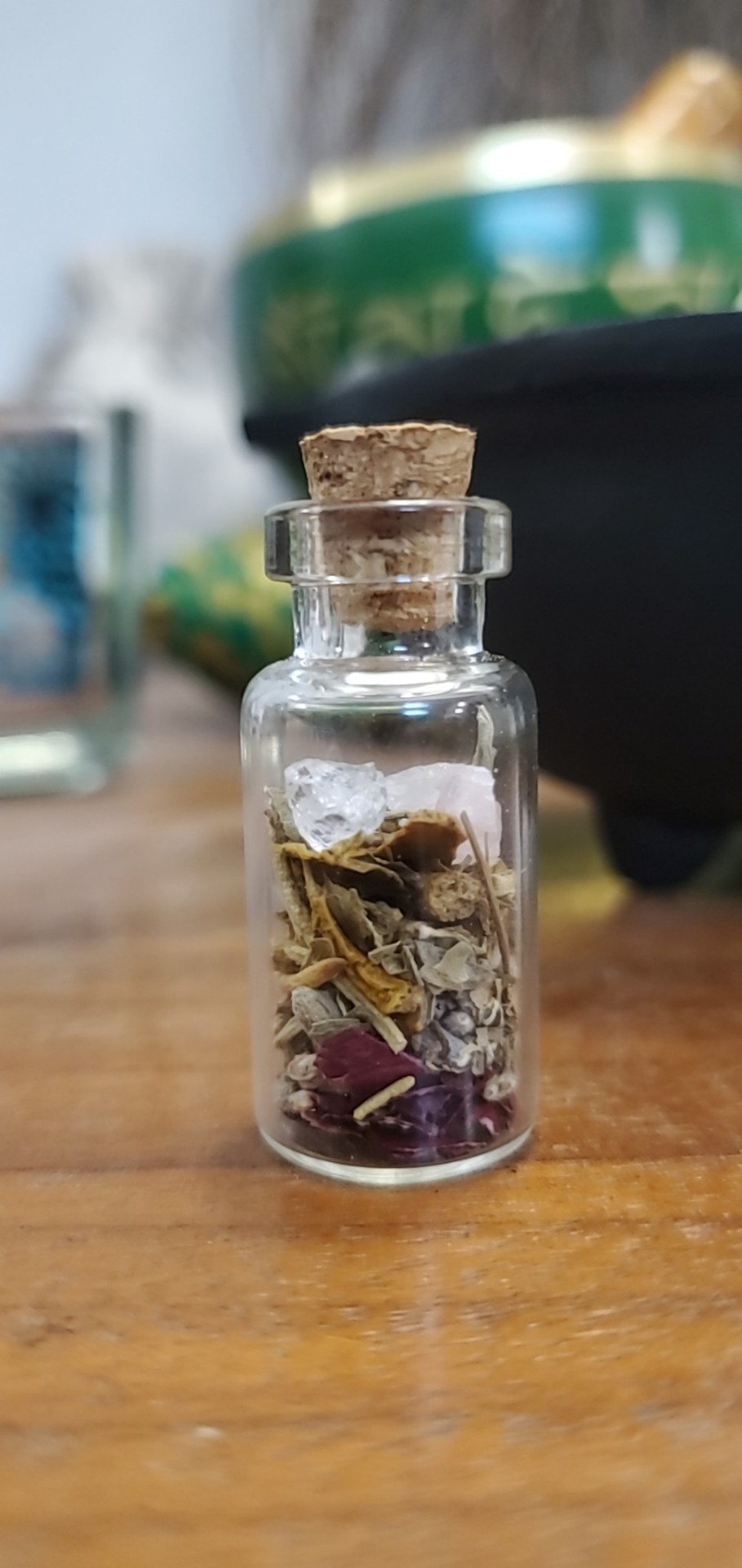
You will need:
Rose petals
Lavender buds
Rosemary
Mistletoe
Basil
Rose quartz shards
Clear quartz shards
A jar
After cleansing yourself, the area, and all the items you'll be using, layer your herbs in the jar in whatever order you please, leaving the crystals for last. While filling your jar, chants the words:
"I am worthy of love."
If you don't have these herbs, feel free to make the spell your own! I create all my own spells through research and intuition. If it feels right, I simply let my instinct guide me. Would love to see how others make a jar with similar intent!

grass green again post rose window crochet blanket :)
Self-Love
Spell Jar to promote feelings of self worth, confidence and love.
Rose (healing, confidence, love)
Cinnamon (happiness)
Rosemary (protection, love)
Lavender (peace, strength, happiness)
Pink salt (cleanse, love)
Rose quartz (self love, compassion)
Intention
Pink wax
Substitute or exclude any materials as you need.
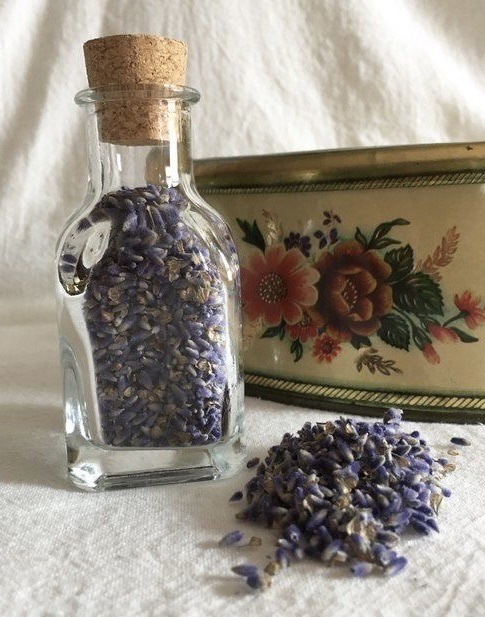

Love <3
how to start reading again
from someone who was a voracious reader until high school and is now getting back into it in her twenties.
start with an old favourite. even though it felt a little silly, i re-read the harry potter series one christmas and it wiped away my worry that i wasn't capable of reading anymore. they are long books, but i was still able to get completely immersed and to read just as fast as i had years and years ago.
don't be afraid of "easier" books. before high school i was reading the french existentialists, but when getting back into reading, i picked up lucinda riley and sally rooney. not my favourite authors by far, but easier to read while not being totally terrible. i needed to remind myself that only choosing classics would not make me a better or smarter person. if a book requires a slower pace of reading to be understood, it's easier to just drop it, which is exactly what i wanted to avoid at first.
go for essays and short stories. no need to explain this one: the shorter the whole, the less daunting it is. i definitely avoided all books over 350 pages at first and stuck to essay collections until i suddenly devoured donna tartt's goldfinch.
remember it's okay not to finish. i was one of those people who finished every book they started, but not anymore! if i pick up a book at the library and after a few chapters realise i'd rather not read it, i just return it. (another good reason to use your local library! no money spent on books you might end up disliking.)
analyse — or don't. some people enjoy reading more when they take notes or really stop to think about the contents. for me, at first, it was more important to build the habit of reading, and the thought of analysing what i read felt daunting. once i let go of that expectation, i realised i naturally analyse and process what i read anyway.
read when you would usually use your phone. just as i did when i was a child, i try to read when eating, in the bathroom, on public transport, right before sleeping. i even read when i walk, because that's normally a time i stare at my screen anyway. those few pages you read when you brush your teeth and wait for a friend very quickly stack up.
finish the chapter. if you have time, try to finish the part you're reading before closing the book. usually i find i actually don't want to stop reading once i get to the end of a chapter — and if i do, it feels like a good place to pick up again later.
try different languages. i was quickly approaching a reading slump towards the end of my exchange year, until i realised i had only had access to books in english and that, despite my fluency, i was tired of the language. so as soon as i got back home i started picking up books in my native tongue, which made reading feel much easier and more fun again! after some nine months, i'm starting to read in english again without it feeling like a huge task.
forget what's popular. i thought social media would be a fun way to find interesting books to read, but i quickly grew frustrated after hating every single book i picked up on some influencer's recommendation. it's certainly more time-consuming to find new books on your own, but this way i don't despise every novel i pick up.
remember it isn't about quantity. the online book community's endless posts about reading 150 books each year or 6 books in a single day easily make us feel like we're slow, bad readers, but here's the thing: it does not matter at all how many books you read or what your reading pace is. we all lead different lives, just be proud of yourself for reading at all!
stop stressing about it. we all know why reading is important, and since the pandemic reading has become an even more popular hobby than it was before (which is wonderful!). however, there's no need to force yourself to be "a reader". pick up a book every now and then and keep reading if you enjoy it, but not reading regularly doesn't make you any less of a good person. i find the pressure to become "a person who reads" or to rediscover my inner bookworm only distances me from the very act of reading.
rank the kids from "would destroy the batmobile in less than 10 minutes if left alone" to "Bruce wouldn't notice for 2 weeks if you took it for a joyride"
Canonically can't drive – Cassandra
Can drive but can't operate the controls – Duke
He's 3 feet tall, that's a fender bender waiting to happen – Damian
Promptly returned it because he felt bad – Cullen
She's 13 – Carrie
Failed her driving test so many times the DMV just gave her a license so she'd stop bothering them – Stephanie
Tried to pull a quick one as an only child so as punishment he's no longer an only child – Dick
Could pilot it remotely while borrowing her neighbor's WiFi – Barbara
Made it halfway to Central City before getting a ticket – Harper
Slowly stole the parts and reassembled it somewhere else, waiting for the opportunity to pull up next to Bruce with his second secret Batmobile – Jason
Leaves it where it normally is but gaslights Bruce into thinking it's gone – Tim
Words for Skin Tone | How to Describe Skin Color
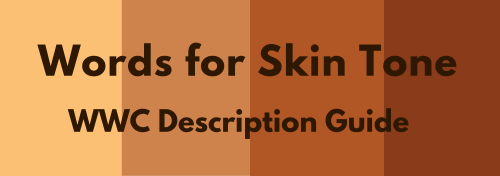
We discussed the issues describing People of Color by means of food in Part I of this guide, which brought rise to even more questions, mostly along the lines of “So, if food’s not an option, what can I use?” Well, I was just getting to that!
This final portion focuses on describing skin tone, with photo and passage examples provided throughout. I hope to cover everything from the use of straight-forward description to the more creatively-inclined, keeping in mind the questions we’ve received on this topic.
Standard Description
Basic Colors

Pictured above: Black, Brown, Beige, White, Pink.
“She had brown skin.”
This is a perfectly fine description that, while not providing the most detail, works well and will never become cliché.
Describing characters’ skin as simply brown or beige works on its own, though it’s not particularly telling just from the range in brown alone.
Complex Colors
These are more rarely used words that actually “mean” their color. Some of these have multiple meanings, so you’ll want to look into those to determine what other associations a word might have.

Pictured above: Umber, Sepia, Ochre, Russet, Terra-cotta, Gold, Tawny, Taupe, Khaki, Fawn.
Complex colors work well alone, though often pair well with a basic color in regards to narrowing down shade/tone.
For example: Golden brown, russet brown, tawny beige…
As some of these are on the “rare” side, sliding in a definition of the word within the sentence itself may help readers who are unfamiliar with the term visualize the color without seeking a dictionary.
“He was tall and slim, his skin a russet, reddish-brown.”
Comparisons to familiar colors or visuals are also helpful:
“His skin was an ochre color, much like the mellow-brown light that bathed the forest.”
Modifiers
Modifiers, often adjectives, make partial changes to a word.The following words are descriptors in reference to skin tone.
Dark - Deep - Rich - Cool
Warm - Medium - Tan
Fair - Light - Pale
Rich Black, Dark brown, Warm beige, Pale pink…
If you’re looking to get more specific than “brown,” modifiers narrow down shade further.
Keep in mind that these modifiers are not exactly colors.
As an already brown-skinned person, I get tan from a lot of sun and resultingly become a darker, deeper brown. I turn a pale, more yellow-brown in the winter.
While best used in combination with a color, I suppose words like “tan” “fair” and “light” do work alone; just note that tan is less likely to be taken for “naturally tan” and much more likely a tanned White person.
Calling someone “dark” as description on its own is offensive to some and also ambiguous. (See: Describing Skin as Dark)
Undertones
Undertones are the colors beneath the skin, seeing as skin isn’t just one even color but has more subdued tones within the dominating palette.
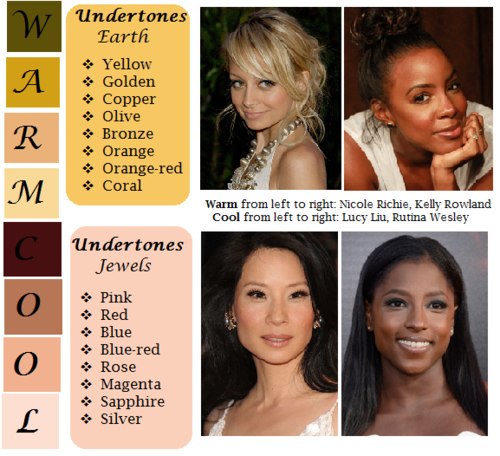
pictured above: warm / earth undertones: yellow, golden, copper, olive, bronze, orange, orange-red, coral | cool / jewel undertones: pink, red, blue, blue-red, rose, magenta, sapphire, silver.
Mentioning the undertones within a character’s skin is an even more precise way to denote skin tone.
As shown, there’s a difference between say, brown skin with warm orange-red undertones (Kelly Rowland) and brown skin with cool, jewel undertones (Rutina Wesley).
“A dazzling smile revealed the bronze glow at her cheeks.”
“He always looked as if he’d ran a mile, a constant tinge of pink under his tawny skin.”
Standard Description Passage
“Farah’s skin, always fawn, had burned and freckled under the summer’s sun. Even at the cusp of autumn, an uneven tan clung to her skin like burrs. So unlike the smooth, red-brown ochre of her mother, which the sun had richened to a blessing.”
-From my story “Where Summer Ends” featured in Strange Little Girls
Here the state of skin also gives insight on character.
Note my use of “fawn” in regards to multiple meaning and association. While fawn is a color, it’s also a small, timid deer, which describes this very traumatized character of mine perfectly.
Though I use standard descriptions of skin tone more in my writing, at the same time I’m no stranger to creative descriptions, and do enjoy the occasional artsy detail of a character.
Creative Description
Whether compared to night-cast rivers or day’s first light…I actually enjoy seeing Characters of Colors dressed in artful detail.
I’ve read loads of descriptions in my day of white characters and their “smooth rose-tinged ivory skin”, while the PoC, if there, are reduced to something from a candy bowl or a Starbucks drink, so to actually read of PoC described in lavish detail can be somewhat of a treat.
Still, be mindful when you get creative with your character descriptions. Too many frills can become purple-prose-like, so do what feels right for your writing when and where. Not every character or scene warrants a creative description, either. Especially if they’re not even a secondary character.
Using a combination of color descriptions from standard to creative is probably a better method than straight creative. But again, do what’s good for your tale.
Natural Settings - Sky

Pictured above: Harvest Moon -Twilight, Fall/Autumn Leaves, Clay, Desert/Sahara, Sunlight - Sunrise - Sunset - Afterglow - Dawn- Day- Daybreak, Field - Prairie - Wheat, Mountain/Cliff, Beach/Sand/Straw/Hay.
Now before you run off to compare your heroine’s skin to the harvest moon or a cliff side, think about the associations to your words.
When I think cliff, I think of jagged, perilous, rough. I hear sand and picture grainy, yet smooth. Calm. mellow.
So consider your character and what you see fit to compare them to.
Also consider whose perspective you’re describing them from. Someone describing a person they revere or admire may have a more pleasant, loftier description than someone who can’t stand the person.
“Her face was like the fire-gold glow of dawn, lifting my gaze, drawing me in.”
“She had a sandy complexion, smooth and tawny.”
Even creative descriptions tend to draw help from your standard words.
Flowers
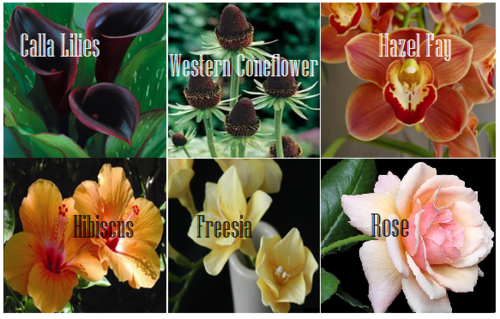
Pictured above: Calla lilies, Western Coneflower, Hazel Fay, Hibiscus, Freesia, Rose
It was a bit difficult to find flowers to my liking that didn’t have a 20 character name or wasn’t called something like “chocolate silk” so these are the finalists.
You’ll definitely want to avoid purple-prose here.
Also be aware of flowers that most might’ve never heard of. Roses are easy, as most know the look and coloring(s) of this plant. But Western coneflowers? Calla lilies? Maybe not so much.
“He entered the cottage in a huff, cheeks a blushing brown like the flowers Nana planted right under my window. Hazel Fay she called them, was it?”
Assorted Plants & Nature

Pictured above: Cattails, Seashell, Driftwood, Pinecone, Acorn, Amber
These ones are kinda odd. Perhaps because I’ve never seen these in comparison to skin tone, With the exception of amber.
At least they’re common enough that most may have an idea what you’re talking about at the mention of “pinecone.“
I suggest reading out your sentences aloud to get a better feel of how it’ll sounds.
“Auburn hair swept past pointed ears, set around a face like an acorn both in shape and shade.”
I pictured some tree-dwelling being or person from a fantasy world in this example, which makes the comparison more appropriate.
I don’t suggest using a comparison just “cuz you can” but actually being thoughtful about what you’re comparing your character to and how it applies to your character and/or setting.
Wood

Pictured above: Mahogany, Walnut, Chestnut, Golden Oak, Ash
Wood can be an iffy description for skin tone. Not only due to several of them having “foody” terminology within their names, but again, associations.
Some people would prefer not to compare/be compared to wood at all, so get opinions, try it aloud, and make sure it’s appropriate to the character if you do use it.
“The old warlock’s skin was a deep shade of mahogany, his stare serious and firm as it held mine.”
Metals

Pictured above: Platinum, Copper, Brass, Gold, Bronze
Copper skin, brass-colored skin, golden skin…
I’ve even heard variations of these used before by comparison to an object of the same properties/coloring, such as penny for copper.
These also work well with modifiers.
“The dress of fine white silks popped against the deep bronze of her skin.”
Gemstones - Minerals
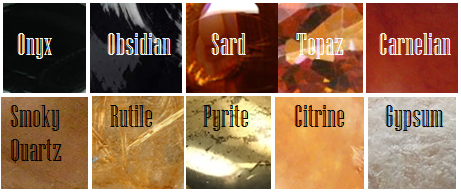
Pictured above: Onyx, Obsidian, Sard, Topaz, Carnelian, Smoky Quartz, Rutile, Pyrite, Citrine, Gypsum
These are trickier to use. As with some complex colors, the writer will have to get us to understand what most of these look like.
If you use these, or any more rare description, consider if it actually “fits” the book or scene.
Even if you’re able to get us to picture what “rutile” looks like, why are you using this description as opposed to something else? Have that answer for yourself.
“His skin reminded her of the topaz ring her father wore at his finger, a gleaming stone of brown, mellow facades.”
Physical Description
Physical character description can be more than skin tone.
Show us hair, eyes, noses, mouth, hands…body posture, body shape, skin texture… though not necessarily all of those nor at once.
Describing features also helps indicate race, especially if your character has some traits common within the race they are, such as afro hair to a Black character.
How comprehensive you decide to get is up to you. I wouldn’t overdo it and get specific to every mole and birthmark. Noting defining characteristics is good, though, like slightly spaced front teeth, curls that stay flopping in their face, hands freckled with sunspots…
General Tips
Indicate Race Early: I suggest indicators of race be made at the earliest convenience within the writing, with more hints threaded throughout here and there.
Get Creative On Your Own: Obviously, I couldn’t cover every proper color or comparison in which has been “approved” to use for your characters’ skin color, so it’s up to you to use discretion when seeking other ways and shades to describe skin tone.
Skin Color May Not Be Enough: Describing skin tone isn’t always enough to indicate someone’s ethnicity. As timeless cases with readers equating brown to “dark white” or something, more indicators of race may be needed.
Describe White characters and PoC Alike: You should describe the race and/or skin tone of your white characters just as you do your Characters of Color. If you don’t, you risk implying that White is the default human being and PoC are the “Other”).
PSA: Don’t use “Colored.” Based on some asks we’ve received using this word, I’d like to say that unless you or your character is a racist grandmama from the 1960s, do not call People of Color “colored” please.
Not Sure Where to Start? You really can’t go wrong using basic colors for your skin descriptions. It’s actually what many people prefer and works best for most writing. Personally, I tend to describe my characters using a combo of basic colors + modifiers, with mentions of undertones at times. I do like to veer into more creative descriptions on occasion.
Want some alternatives to “skin” or “skin color”? Try: Appearance, blend, blush, cast, coloring, complexion, flush, glow, hue, overtone, palette, pigmentation, rinse, shade, sheen, spectrum, tinge, tint, tone, undertone, value, wash.
Skin Tone Resources
List of Color Names
The Color Thesaurus
Skin Undertone & Color Matching
Tips and Words on Describing Skin
Photos: Undertones Described (Modifiers included)
Online Thesaurus (try colors, such as “red” & “brown”)
Don’t Call me Pastries: Creative Skin Tones w/ pics I
Writing & Description Guides
WWC Featured Description Posts
WWC Guide: Words to Describe Hair
Writing with Color: Description & Skin Color Tags
7 Offensive Mistakes Well-intentioned Writers Make
I tried to be as comprehensive as possible with this guide, but if you have a question regarding describing skin color that hasn’t been answered within part I or II of this guide, or have more questions after reading this post, feel free to ask!
~ Mod Colette
love manifestation 💋
You will need ~
-A piece of paper
-A pen (preferred red/pink)
-Red/pink lipstick
-Crystals (optional)
-Red/pink/white string
-Red/pink/white candle
Get a piece of paper and fill it with how much said person loves you (eg; __ is obsessed about me, __ dreams about me .etc)
Add hearts to the page
Fold it towards you and turn clockwise about three times
Hold it to your heart and visualise the paper being engulfed by a glowing red/white light and think about said person being in love with you
Label the paper ‘LOVE’ like your sending a letter
Put on lipstick and kiss the paper a couple of times
Drip candle wax on it
Leave it on your alter to charge for atleast a few hours (optionally with crystals around and on top of it)
After it’s charged, remove the crystals and tie a red string around it
Leave it in a manifestation box or at least store it in your alter
hope this helps <3
We need to talk about Titus
Out of all the discussions around the Hunger Games, the one discussion I have yet to see is one around the past Tribute and "cannibal", Titus.
It strikes me as an extremely odd detail to be randomly thrown in, not only being one of the only past non-victor tributes to have a name, (and the only one that isn't from the 10th and 74th games or Maysilee Donner, who has further significance to the plot) but also having such a wild story. Titus being relegated to a one-off line is extremely confusing to me.
But what's more confusing is how he's treated, both in-universe by other tributes, and irl by readers/fans. And I think Capitol Propaganda has a lot to do with it.
The little we do know about Titus is:
He was from District 6
He was anywhere from 12-18 years old
He was killed by an *avalanche*
He was "crazy" and snapped during the games
He cannibalized the hearts of the tributes he killed
Right away, this tells me that there's more to Titus than just having lost it, or even being mentally ill prior to the games, though that may have had a part. However, it's definitely not the main factor at play.
Firstly, we need to look at how the Capitol treats these literal children in the short time that they're being prepared to fight to the death. They're almost constantly in the public eye, pushed to train, and treated like commodities for the residents of the Capitol. Residents who live in opulence, compared to the poverty and struggles of the rest of the districts. District 6 especially, where Titus is from, seems to have had a rough time, what with an implied morphling problem and their focus being Transport, meaning that their tributes have absolutely no prior skills that would be useful in the games.
Combining all of these factors, and we don't have to make a leap to assume that Titus would already be under a lot of stress from the get-go.
Then, consider the Arena. This is where the avalanche comes into play. An avalanche would mean snow, which would mean that the arena was likely some sort of tundra, or at least was winter-like. From other games, it has been shown that the gamemakers will purposely make it difficult for tributes to access basic resources like water or food. If Titus had been unlucky at the cornucopia, he would be hard-pressed to find food in a snow-covered environment.
And these two factors, stress and hunger, make it pretty clear to me why Titus did what he did, and why that's so important to the rest of the story as a whole.
Titus. Was. Starving.
Desperation for food, stress from what he'd already gone through, and the fact that Titus was a child makes it pretty clear that if he "snapped", it wasn't because he was insane, it was because of the Capitol.
And the tragedy of this is that the Capitol pushed this boy to desperation, and because he lashed out at them for it (and they found his actions in desperation "unsightly"), they tazed him, they killed him, and they framed the entire situation as this "monstrous crazy person gone rogue".
The Capitol once again kept the people blind to their cruelty, but this time, they even did so to us, the reader.
staff: we have an update!
all of tumblr:

staff: you can now make polls!
all of tumblr:

-
 spiderfreak reblogged this · 8 months ago
spiderfreak reblogged this · 8 months ago -
 sillylittlewitchling liked this · 10 months ago
sillylittlewitchling liked this · 10 months ago -
 lustforlife00 liked this · 11 months ago
lustforlife00 liked this · 11 months ago -
 jizzing-bastard-600and69 liked this · 1 year ago
jizzing-bastard-600and69 liked this · 1 year ago -
 rainbowmarvel201 liked this · 1 year ago
rainbowmarvel201 liked this · 1 year ago -
 iwantpieandplaid liked this · 1 year ago
iwantpieandplaid liked this · 1 year ago -
 fairysoftgirl liked this · 1 year ago
fairysoftgirl liked this · 1 year ago -
 ihavetoomanyfeelingshelpmeeee liked this · 1 year ago
ihavetoomanyfeelingshelpmeeee liked this · 1 year ago -
 nana-thee-galaxy-g1rl liked this · 1 year ago
nana-thee-galaxy-g1rl liked this · 1 year ago -
 ironconnoisseurmusic liked this · 1 year ago
ironconnoisseurmusic liked this · 1 year ago -
 lifeandbandmembers-blog liked this · 2 years ago
lifeandbandmembers-blog liked this · 2 years ago -
 starseedangelll liked this · 2 years ago
starseedangelll liked this · 2 years ago -
 lostdragonrider liked this · 2 years ago
lostdragonrider liked this · 2 years ago -
 forget-me-ghost liked this · 2 years ago
forget-me-ghost liked this · 2 years ago -
 therosiethings liked this · 2 years ago
therosiethings liked this · 2 years ago -
 imeanwhynotbruv liked this · 2 years ago
imeanwhynotbruv liked this · 2 years ago -
 chaosandwolves liked this · 2 years ago
chaosandwolves liked this · 2 years ago -
 kaffeeaddictandproud liked this · 2 years ago
kaffeeaddictandproud liked this · 2 years ago -
 hickory-smoked-ass reblogged this · 2 years ago
hickory-smoked-ass reblogged this · 2 years ago -
 hickory-smoked-ass liked this · 2 years ago
hickory-smoked-ass liked this · 2 years ago -
 doughycookie reblogged this · 2 years ago
doughycookie reblogged this · 2 years ago -
 doughycookie liked this · 2 years ago
doughycookie liked this · 2 years ago -
 mjanddeacy liked this · 2 years ago
mjanddeacy liked this · 2 years ago -
 writingwithspink liked this · 2 years ago
writingwithspink liked this · 2 years ago -
 queen-helaenas-pet-spider reblogged this · 2 years ago
queen-helaenas-pet-spider reblogged this · 2 years ago -
 queen-helaenas-pet-spider liked this · 2 years ago
queen-helaenas-pet-spider liked this · 2 years ago -
 fanficlover21 liked this · 2 years ago
fanficlover21 liked this · 2 years ago -
 coolerontheinternetdotcom liked this · 2 years ago
coolerontheinternetdotcom liked this · 2 years ago -
 mortalsiren liked this · 2 years ago
mortalsiren liked this · 2 years ago -
 mychemicalkidromance liked this · 2 years ago
mychemicalkidromance liked this · 2 years ago -
 stuckyprotectionsquad liked this · 2 years ago
stuckyprotectionsquad liked this · 2 years ago -
 mrmssm-a liked this · 2 years ago
mrmssm-a liked this · 2 years ago -
 justarandomnbfan liked this · 2 years ago
justarandomnbfan liked this · 2 years ago -
 eddieheart liked this · 2 years ago
eddieheart liked this · 2 years ago -
 what-the-heckin-heck liked this · 2 years ago
what-the-heckin-heck liked this · 2 years ago -
 moderngenius94 liked this · 2 years ago
moderngenius94 liked this · 2 years ago -
 slytherinawayfromyou reblogged this · 2 years ago
slytherinawayfromyou reblogged this · 2 years ago -
 bellamuerte-13 reblogged this · 2 years ago
bellamuerte-13 reblogged this · 2 years ago -
 bellamuerte-13 liked this · 2 years ago
bellamuerte-13 liked this · 2 years ago -
 thespookshow liked this · 2 years ago
thespookshow liked this · 2 years ago -
 gabbiskylar01 liked this · 2 years ago
gabbiskylar01 liked this · 2 years ago -
 jelly-sullii reblogged this · 2 years ago
jelly-sullii reblogged this · 2 years ago -
 livingdeadgurl liked this · 2 years ago
livingdeadgurl liked this · 2 years ago -
 spookyghost-time reblogged this · 2 years ago
spookyghost-time reblogged this · 2 years ago -
 laneunderwave liked this · 2 years ago
laneunderwave liked this · 2 years ago -
 thisweirdkidsnightmare liked this · 2 years ago
thisweirdkidsnightmare liked this · 2 years ago -
 blissdreamer13 liked this · 2 years ago
blissdreamer13 liked this · 2 years ago -
 nogi-nogitsune liked this · 2 years ago
nogi-nogitsune liked this · 2 years ago -
 cavinginhisfvce liked this · 2 years ago
cavinginhisfvce liked this · 2 years ago
